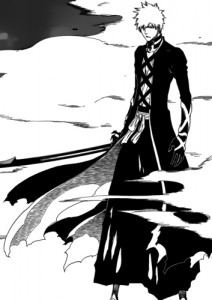If you ask a manga reader from the mid-2000s what the big 3 manga were, chances are you’d hear the following responses: Naruto, Bleach, and One Piece.
It’s now a decade later. Naruto has ended. One Piece is still going strong. And Bleach… Well, Bleach is still going.
If you talk to those same 2005 manga readers about Bleach, you’re likely going to hear similar responses. “Oh, it’s still running? It hasn’t ended yet?” or “Wow, those ship wars really ruined the fandom for me.” But a couple replies usually pop up again and again. “I stopped reading after the Soul Society arc.” Or perhaps: “Bleach should have ended after the Soul Society arc.”

Let me back up a bit. For those who aren’t familiar with Bleach, it’s a shounen manga series about a high school student named Ichigo Kurosaki, who has the ability to see ghosts. One day, he meets a Shinigami, or death god, named Rukia Kuchiki. Her Shinigami abilities accidentally transfer to Ichigo and as a result, he ends up taking over her duties. For various reasons, this is a crime and it eventually catches up to them. Rukia is taken back to Soul Society, the spirit world home of the Shinigami and the ghosts under their care, to be executed. The Soul Society story arc spans the chapters where Ichigo and his friends break into Soul Society to save her.
But here’s the thing: Saying you stopped reading after this story arc, or that the comic series should have ended there, implies that the narrative would have been complete. Would it?
Let me tell you something. I reread all of Bleach after reminiscing about anime redhead Renji Abarai. Ending Bleach after Soul Society would have been a terrible idea. Why? Because it’s not an actual ending. It’s not even a narrative breather. It is in fact the opening salvo to a bigger story arc in which we learn that Sousuke Aizen is the biggest bad to ever bad.

This isn’t to say Bleach is narratively good after the Soul Society arc. That’s the problem with Bleach. There are no highs or lows. There are no soaring victories for us to celebrate or emotional lows for us to scream about. It’s surprisingly one note, and it all goes back to Aizen.
See, we know Aizen’s the big bad. But he’s introduced so early, encountered in a climactic fight so early in the series that we get no build-up to a final boss battle. Instead, we get a drawn out series of fights and encounters as various henchmen and underlings try to stop Ichigo and his friends. But it’s hard to get emotionally invested in these fights—no matter how cool those characters may look—when we know they’re just filling space until Aizen finally decides to take the stage.
We discover Aizen’s nefarious plans in Chapter 178 of the manga. Ichigo and his pals finally defeat him in Chapter 423. That’s almost 250 chapters to defeat a bad guy! Are you even serious?
By contrast, at 400 chapters in, Naruto has already fought Sasuke, lost Sasuke, had a time skip, and is well on his way to fighting in a world war. One Piece is in the middle of its majestic Enies Lobby story arc and the Strawhat Crew has declared war on the World Government.
Make no mistake. Kubo Tite draws some stylish characters, and those characters can be pretty cool. But because so many of them are simply filler, they lack depth. They’re introduced, defeated, and forgotten. Some popular ones may come back later, but their reappearance brings no nuance or dimension. Good characters can make up for a flagging narrative (see: Naruto), but alas, Bleach has neither.
Sadly, Bleach continued its serialization after Aizen was finally defeated. Which was strange because, unlike the conclusion of the Soul Society arc, that would have been the perfect place to end the series. Everything was tied up. There were no loose threads.
But no. It kept going. Ichigo loses his supernatural abilities after defeating Aizen, right? He becomes completely a normal high school student. A fitting ending to a series about a boy tired of his ability to see ghosts. It doesn’t last. We soon launch into a new story arc in which Ichigo is forced to regain his supernatural abilities for convoluted reasons that involve people wanting to steal them. Yes, people want to steal abilities he doesn’t actually have so they have to help him get them first! That’s a lot of effort, isn’t it?
Worse still? The manga is still going—even though Weekly Shounen Jump made a clear announcement a couple years back that the series was ending. Naruto has ended in the time between that announcement and now. What gives?
Having caught up to the current ongoings in the manga, I can tell it’s proceeding toward a final, culminating battle. Slowly. In the most meandering fashion ever. Which is a pity. Like Rurouni Kenshin and Fullmetal Alchemist, shounen manga series should end with a bang.
But Bleach appears to be heading toward a gasping, choked whimper.

